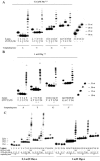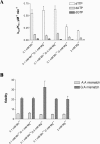Human replication protein A can suppress the intrinsic in vitro mutator phenotype of human DNA polymerase lambda
- PMID: 16522650
- PMCID: PMC1390690
- DOI: 10.1093/nar/gkl032
Human replication protein A can suppress the intrinsic in vitro mutator phenotype of human DNA polymerase lambda
Abstract
DNA polymerase lambda (pol lambda) is a member of the X family DNA polymerases and is endowed with multiple enzymatic activities. In this work we investigated the in vitro miscoding properties of full-length, human pol lambda either in the absence or in the presence of the human auxiliary proteins proliferating cell nuclear antigen (PCNA) and replication protein A (RP-A). Our data suggested that (i) pol lambda had an intrinsic ability to create mismatches and to incorporate ribonucleotides at nearly physiological Mn++ and Mg++ concentrations; (ii) the sequence of the template-primer could influence the misincorporation frequency of pol lambda; (iii) pol lambda preferentially generated G:T and G:G mismatches; (iv) RP-A, but not PCNA, selectively prevented misincorporation of an incorrect nucleotide by pol lambda, without affecting correct incorporation and (v) this inhibitory effect required a precise ratio between the concentrations of pol lambda and RP-A. Possible physiological implications of these findings for the in vivo fidelity of pol lambda are discussed.
Figures





Similar articles
-
DNA polymerase lambda directly binds to proliferating cell nuclear antigen through its confined C-terminal region.Genes Cells. 2005 Jul;10(7):705-15. doi: 10.1111/j.1365-2443.2005.00868.x. Genes Cells. 2005. PMID: 15966901
-
Human DNA polymerase lambda diverged in evolution from DNA polymerase beta toward specific Mn(++) dependence: a kinetic and thermodynamic study.Biochemistry. 2003 Jun 24;42(24):7467-76. doi: 10.1021/bi034198m. Biochemistry. 2003. PMID: 12809503
-
Fidelity of DNA polymerase delta holoenzyme from Saccharomyces cerevisiae: the sliding clamp proliferating cell nuclear antigen decreases its fidelity.Biochemistry. 2003 Dec 9;42(48):14207-13. doi: 10.1021/bi0348359. Biochemistry. 2003. PMID: 14640688
-
Properties and functions of Escherichia coli: Pol IV and Pol V.Adv Protein Chem. 2004;69:229-64. doi: 10.1016/S0065-3233(04)69008-5. Adv Protein Chem. 2004. PMID: 15588845 Review.
-
Translesion synthesis in Escherichia coli: lessons from the NarI mutation hot spot.DNA Repair (Amst). 2007 Jul 1;6(7):1032-41. doi: 10.1016/j.dnarep.2007.02.021. Epub 2007 Apr 2. DNA Repair (Amst). 2007. PMID: 17403618 Review.
Cited by
-
For the Better or for the Worse? The Effect of Manganese on the Activity of Eukaryotic DNA Polymerases.Int J Mol Sci. 2023 Dec 27;25(1):363. doi: 10.3390/ijms25010363. Int J Mol Sci. 2023. PMID: 38203535 Free PMC article. Review.
-
Expanding the repertoire of DNA polymerase substrates: template-instructed incorporation of non-nucleoside triphosphate analogues by DNA polymerases beta and lambda.Nucleic Acids Res. 2007;35(1):45-57. doi: 10.1093/nar/gkl1016. Epub 2006 Dec 5. Nucleic Acids Res. 2007. PMID: 17148482 Free PMC article.
-
A dynamic model for replication protein A (RPA) function in DNA processing pathways.Nucleic Acids Res. 2006;34(15):4126-37. doi: 10.1093/nar/gkl550. Epub 2006 Aug 25. Nucleic Acids Res. 2006. PMID: 16935876 Free PMC article. Review.
-
Error-free bypass of 2-hydroxyadenine by human DNA polymerase lambda with Proliferating Cell Nuclear Antigen and Replication Protein A in different sequence contexts.Nucleic Acids Res. 2007;35(15):5173-81. doi: 10.1093/nar/gkm568. Epub 2007 Jul 30. Nucleic Acids Res. 2007. PMID: 17666409 Free PMC article.
-
Replication protein A and proliferating cell nuclear antigen coordinate DNA polymerase selection in 8-oxo-guanine repair.Proc Natl Acad Sci U S A. 2008 Dec 30;105(52):20689-94. doi: 10.1073/pnas.0811241106. Epub 2008 Dec 22. Proc Natl Acad Sci U S A. 2008. PMID: 19104052 Free PMC article.
References
-
- Hubscher U., Maga G., Spadari S. Eukaryotic DNA polymerases. Annu Rev. Biochem. 2002;71:133–163. - PubMed
-
- Garcia-Diaz M., Dominguez O., Lopez-Fernandez L.A., de Lera L.T., Saniger M.L., Ruiz J.F., Parraga M., Garcia-Ortiz M.J., Kirchhoff T., del Mazo J., et al. DNA polymerase lambda (Pol lambda), a novel eukaryotic DNA polymerase with a potential role in meiosis. J. Mol. Biol. 2000;301:851–867. - PubMed
-
- Ramadan K., Shevelev I., Hubscher U. The DNA-polymerase-X family: controllers of DNA quality? Nat. Rev. Mol. Cell Biol. 2004;5:1038–1043. - PubMed
-
- Maga G., Villani G., Ramadan K., Shevelev I., Le Gac N.T., Blanco L., Blanca G., Spadari S., Hubscher U. Human DNA polymerase lambda functionally and physically interacts with proliferating cell nuclear antigen in normal and translesion DNA synthesis. J. Biol. Chem. 2002;277:48434–48440. - PubMed
-
- Maga G., Blanca G., Shevelev I., Frouin I., Ramadan K., Spadari S., Villani G., Hubscher U. The human DNA polymerase lambda interacts with PCNA through a domain important for DNA primer binding and the interaction is inhibited by p21/WAF1/CIP1. Faseb J. 2004;18:1743–1745. - PubMed
Publication types
MeSH terms
Substances
LinkOut - more resources
Full Text Sources
Miscellaneous

